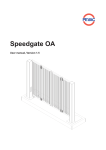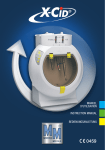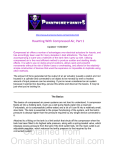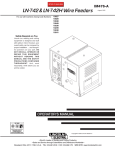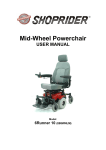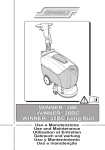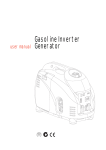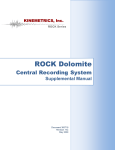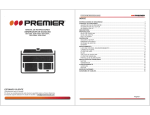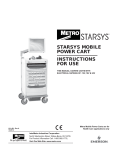Download Mart Cart 3563 Operating instructions
Transcript
Mart Cart Model 3563 Technical Overview This document is a technical overview of the Mart Cart model 3563. Its purpose is to describe the major components of units that are currently being produced. Some components may be updated from previous versions of this model. Some optional components may not be discussed in this document. For more detailed information, please contact our Service Department at 800-548-3373 or email [email protected]. Go to the Table of Contents Table of Contents • • • • • • • • • Major Parts Overview Potentiometer/PWM Relationship Calibrate PWM Parts List Wiring Diagram Tools Safety Check Warranty Serial Number Label Click on one of the subjects above to jump directly to the document page. Major Parts Overview • • • • • • Battery/Circuit Breaker Charger Wire Harness PWM Control Box Hub Motor Return to Table of Contents Battery/Circuit Breaker The battery is a 12 volt, AGM (Absorbent Glass Mat), 35 Amp Hour, Sealed Lead Acid (SLA) battery. The “quick change” battery cover houses the 15 amp circuit breaker, 5 amp fuse, and main wire harness. 280-1214 280-1712 260-1228 280-1799 (Mini Fuse) 280-1627 (Fuse) Prior to the quick change battery cover, a 15 amp circuit breaker was attached directly to the negative post of the battery. The copper terminal of the circuit breaker is attached to the battery terminal with a lock nut. The black wire lead of the main wire harness is attached to the stainless steel terminal of the circuit breaker. 280-1610 Return to Major Parts Overview Copper Stainless Charger The charger is a 12 volt, 7amp charger with Intelli-Charge™ functionality. Intelli-Charge monitors the charge capacity of the battery. The charger shuts down when then battery is completely charged. This feature allows the battery to be plugged into a wall socket for any length of time without concern about over-charging. The charger has 3 output wires and is plugged directly into the main wire harness with a 3-pin connector. The positive and negative wires go to the battery, and an “inhibit” wire goes to the PWM. The inhibit wire carries voltage to the PWM on pin 7 when the charger is plugged in and charging the battery. Voltage on pin 7 “inhibits” the PWM from outputting voltage to the motor thus not allowing the cart to be operated when the charger is plugged in. Note: The charger uses power cord 280-1797. The previous version of the charger uses power cord 280-1647 (“D” Plug). 280-1749 3-pin connector Return to Major Parts Overview Wire Harness Steering – includes 6-pin, 3-pin, and 10-pin Main – part of the quickconnectors, clamps change battery cover and 18 inch loom assembly. Contains (not shown). 15 amp circuit breaker and 5 amp mini fuse. PWM-to-Motor - includes 4-pin connector. 280-1646 280-1202 280-1712 280-1626 (Wire Guide) 280-1454 Return to Major Parts Overview The earlier version of the main wire harness without the quick-change battery cover contains a 15amp circuit breaker and 5amp fuse. PWM The PWM (Pulse Width Modulator) monitors multiple electronic functions and is the central processor for the cart’s electronics. The PWM (in conjunction with the potentiometer) controls the speed and direction of the motor hub. A 10-pin terminal is designed to monitor the cart’s functions through the control box, charger, and motor. Positive Negative Motor Terminal 10-pin terminals 1 – Black – Pin 1 on pot (ground) 2 – Yellow – Pin 2 on pot (wiper) 3 – Blue – Pin 3 on pot (terminal) 4 – Green – LED 5 – Orange – LED 6 – White – Common (power) 7 – Yellow – Inhibit from charger 8 – Violet – Horn 9 – Brown – Brake 10 – Not used Return to Major Parts Overview Positive Battery Terminal 10-pin Terminal Motor Terminal Negative Battery Terminal 280-1569 Control Box The control box houses the potentiometer and rocker switch (Power Off/On, Horn, LED light). The potentiometer is connected to the control throttle and regulates the resistance on pins 1, 2, and 3 of the PWM. This, in turn, controls the speed and direction of the motor. The rocker switch has an imbedded LED that indicates the battery charge process when the charger is plugged in and indicates the battery charge level while the cart is in service. When charging When in service 280-1405 (Rocker Switch) Amber - Charging Green - Charged Green - Good Charge Amber - Moderate Charge Red - Low (needs charging) 280-1228 Note: The control box has optional configurations. Please call the Service Department for detailed information. 280-1187 Return to Major Parts Overview Hub Motor The hub motor is a direct current, brushed disc, 12 (or 24) volt brake, geared motor. The motor is powered through a positive (red) and a negative (black) wire lead protruding from the axle. 280-1600 The brakes are powered by two black wire leads protruding from the opposite axle. The wire leads are pinned and inserted into a 4-pin connector. The brake leads are inserted into slots 1 and 2. The negative power lead is inserted into slot 3 and the positive lead (red) is inserted into slot 4. Return to Major Parts Overview Potentiometer/PWM Relationship The potentiometer (pot) along with the PWM regulates the speed and direction of the motor. The PWM monitors the change in resistance on pins 1, 2, and 3 of the 10-pin connector which are connected to the pot (pins 1, 2, and 3 respectively) through the steering wire harness. The pot is located in the control box and is physically connected to the throttle control on the cart’s handlebars. The resistance is varied by the movement of the thumb-control throttle in a forward and backward direction. In turn, the PWM emits variable voltage to the positive and negative motor leads (connected to the PWM), allowing the motor to move at varied speeds forward and backward. The pot is rated at 5K ohms +/- 10%. This is the resistance between pin 1 and pin 3 on the pot’s terminals. When the pot assembly is set at the factory, the wiper (pin 2) is calculated and preset to 24% of the total resistance (approx 1.08K to 1.32K ohms). The wiper position of the pot is where the PWM looks for the “neutral” position. In the neutral position, the PWM cuts power to the motor leads and brake leads (engaging the brake). Pot PWM 3 2 1 Continued on next page Hub Motor Potentiometer/PWM Relationship Over the life of the cart, several things may happen to disrupt the normal resistance between the pot and the PWM…subsequently sending false readings to the PWM. They are: • • • • • The resistance material in the pot becomes damaged (extremely rare). The shaft sticks/freezes (human error during assembly). The spring or fork of the pot assembly become damaged. The connectors of the steering wire harness loose contact. The wires of the steering wire harness break. When any of these situations occur, the PWM (movement of the cart) may act erratically. Often, the PWM is diagnosed as having a problem when, in fact, a problem exists with the pot, connectors, or wire harness. The PWM is “calibrated” (see next page “Calibrate PWM”) at the factory to the neutral range of the pot. If the pot assembly or wires become damaged, the resistance (and neutral range) of the pot can change. Re-calibrating the PWM may resolve the immediate problem but the fix may not be permanent. The best practice is to validate the condition of the pot, connectors, and wire harness before attempting to re-calibrate the PWM. Return to Table of Contents Calibrate PWM On occasion, the cart may function erratically. As the last step in troubleshooting a problem, the PWM can be “calibrated” to the neutral position of the potentiometer. Be certain that the battery is charged above 10.5 volts and the horn and the seat switch are connected and working properly before attempting to calibrate the PWM. Without them working properly, the PWM will not calibrate. 1. 2. 3. 4. 5. Stand next to the cart. Do not sit on the seat during the calibration steps. Turn the rocker switch to the “ON” position (and the key switch if so equipped). Be sure that the throttle is in neutral position (hands off). Hold down the horn button for a minimum of 10 seconds. Do not let off of the horn. While continuing to hold down the horn, push down and then release in the center of the seat (activating seat switch) 3 times. 6. Wait a second or two and then release the horn. If you hear 2 short chirps, the PWM calibrated successfully. Retest the cart. If you hear 3 short chirps, the PWM did not recognize a brake circuit (see the next page “Check Brake Lead”). If you hear a long chirp in any combination, the PWM did not calibrate successfully. Calibrate again or replace the PWM. Turn on sound and click video Continue on next page Calibrate PWM – Check Brake Leads When attempting to calibrate the PWM one might hear 3 short chirps. This indicates that the PWM did not recognized a brake circuit. The PWM will still function but the brakes will not release causing undesired performance from the motor. To resolve the brake issues, check the brake circuit from the PWM to the motor by disconnecting the brake leads from the wire harness at the PWM and placing an ohm meter on each lead. The meter should read approximately 20 ohms. If you do not get a good reading, run the same test on brake leads from the motor to the 4-pin connector. If you do not get a good reading there, either the male pins in the connector are bad or the brake circuit inside the hub motor is bad…repair the pins or replace the motor. If you get a good reading, then the PWM-to-Motor wire harness is bad or the pins in the 4-pin connector are not making good contact…repair the pins or replace the harness. Return to Table of Contents Brake Leads Parts List Item 1 1a 2 3 4 5 6 7 8 9 10 11 12 13 14 15 16 17 17A 18 18A 19 20 20A 21 22 23 24 25 26 27 28 29 30 31 32 33 Notes: 7 8 10 11 22 24 26 Part# Description 280-1818 Main Frame (contains Bumper/hardware) 280-1840 Bumper Only (with hardware) 280-1268 Rear Wheels – Poly-U, 8” 000-1224 Bushing – 5/8” (1 on each wheel) 280-1335 Grommet – 5/8” (1 on each wheel) 000-1075 Retaining Ring “E” Type (1 on each wheel) 280-1214 Battery – 35AH 280-1797 Charger Cord – 6’ Coiled (See Notes) 260-1228 Circuit Breaker – 15amp (See Notes) 280-1743 Charger – 7AMP, 3-Prong Pigtail 280-1799 Fuse, Mini – 5AMP (See Notes) 280-1712 Battery Cover Assembly – (See Notes) 280-1280 Rear Cover (Select Color Options) 280-1637 Charger Cord Cover 280-1711 Spring Latch Assembly 280-1262 Seat Mount Tube – LH 280-1261 Seat Mount Tube – RH 280-1797 Seat, PVC-Free (includes Seat Switch) 200-1558 Seat, Padded (Optional – includes Seat Switch) 280-1553 Seat Switch (for PVC-Free Seat 280-1797) 280-1484 Seat Switch (for Padded Seat 200-1558) 280-1264 Basket Tube (2 each) 200-1802 Basket, Lil Max 280-1614 Basket Bumpers – 15” (2 each) 200-1236 Basket Mounting Clips (4 each) 280-1626 Wire Guide (See Notes) 280-1202 Wire Harness – Steering 280-1646 Wire Harness – Hub Motor to PWM (See Notes) 280-1569 PWM (Pulse Width Modulator) 280-1454 Wire Harness – Main (part of Battery Cover Assembly) 280-1346 Tire for Hub Motor 280-1279 Front Cover (Select Color Option) 280-1441 Bridge Cover 280-1600 Hub Motor 200-1052 Caster – 2” (2 each) 280-1273 Fork Assembly 280-1281 Floor Cover Steering Column/Controls (See Detail on next page) Use Charger Cord 280-1647 (“D” plug) if cart has 280-1630 charger (older version). Use Circuit Breaker 280-1610 if cart does not have the Battery Cover 280-1712. Use Fuse 280-1627 if cart does not have a Battery Cover 280-1712. Battery Cover Assembly 280-1712 contains Main Wire Harness, Fuse, and Circuit Breaker. Wire Guide Assembly (280-1656) contains Wire Guide (280-1626), Wire Harness (280-1646), and Hardware. Wire Guide Assembly (280-1656) contains Wire Guide (280-1626), Wire Harness (280-1646), and Hardware. Order this part only if cart does not have Battery Cover 280-1712. Return to Table of Contents Optional Parts Part# Description 290-1123 280-1373 200-8153 280-1562 280-1653 200-1393 280-1178 200-1728 280-1440 Jr Basket Jumbo Basket (w/castors and lower shelf) Folding Produce Tray Chek-Riter Safety Flag Cord Reel – 6’ Hour Meter Crutch Holder Assembly Seat Latch Hook Assembly Decals/Signs (English – call for other) Part# Description 200-1382 200-1387 200-1231 200-1299 200-1095 280-1307 000-1183 280-2103 280-1545 280-1532 Sign – Operating Instructions Sign – Personal Injury Sign – No Children Decal – Personal Injury Decal – Load Limits Decal – Pull Latch Decal – High Voltage Decal – Do Not Stand Decal – Charging Instructions Decal – Daily Maintenance Parts List – Steering Column Steering Column and Control Box Parts List Item Parts# Description 1 2 3 4 5 6 7 8 9 10 11 12 280-1178 280-1177 280-1184 280-1187 200-1640 280-1405 280-1863 280-1185 280-1862 280-1602 280-1179 280-1199 Control Box Bottom Cover Control Box Top Cover Control Box Divider Potentiometer Assembly Key Switch (Optional) Rocker Switch Overlay – Control Box Top Overlay – Control Box Front Intelli-Charge Indicator Decal Grip Throttle Grip – Thumb Control Steering Column (w/Rod and Grips) 280-1228 280-1229 280-1230 280-1231 280-1232 Control Box – Keyless (1-4, 6-8) Control Box – Keyed (1-8) Control Box Top – Keyless (2, 4, 6-8) Control Box Top – Keyed (2, 4-8) Control Box Top – w/Decals (2, 7, 8) Control Box Kits Return to Table of Contents Wiring Diagram 6-pin connector 3-pin connector Return to Table of Contents 1 – Black – Pin 1 on pot (Neg) 2 – Yellow – Pin 2 on pot (wiper) 3 – Blue – Pin 3 on pot (terminal) 4 – Green – LED 5 – Orange – LED 6 – White – Power (Pos) 7 – Yellow – Inhibit from charger 8 – Violet – Horn 9 – Brown – Brake 10 – Not used Tools The suggested tool kit should contain: Screwdrivers: #2 Phillips T15 Star #2 Flat Head Wrenches: 3/4” Open End 1/2” Open End 1/2” Box End 10mm Open End Torque Punch or Nail: Sockets: 5/16” 1/4” 7/16” 1/2” Deep Well 1/2” 10mm Pliers: Needle Nose Regular Wire Snips 1/8” Electronics: Multi-meter - Ohms, AC and DC voltage Load Tester - Should be able to load test battery without having to charger the battery first Jumper cable- Alligator clips on both ends Return to Table of Contents Safety Check This checklist is designed for service technicians to use as a guideline when servicing electrical Mart Cart shopping carts. The list covers common system safety features that should be checked for proper installation and functionality. While they may not be presented on this list, all parts and components of the cart should be checked for proper functionality and either fixed or reported to authorized facility personnel. All parts must be OEM to ensure proper safety and warranty compliance. • General Condition – Check for broken frame, tubes, bumpers (frame and basket), basket, handlebars, covers, seats, and armrests. • • • • • • • • • Any part or piece that may snag a person or store display should be repaired. All mounting screws (e.g. front cover screws) should be checked and replaced as necessary. Electrical components – Check all wiring to ensure no evidence of fraying, crimps or cuts. Ensure that the harness is laying inside the rear pan and not in a bind or contact with metal parts or components that could rub through the insulation (for example – between the seat tube and frame on an XTi model cart). Ensure proper circuit breakers are installed and functional. Charger cord – In addition to the other electrical components, check for fraying of charger cord and cord plug for damage. Replace with OEM cord. It is not recommended to replace plug. Casters – Check for proper distance from the floor (about ½ inch). Check for bracket welds and position (perpendicular to the floor). Seat Latch – Ensure that the latch engages properly and that it secures the seat from tilting forward. Horn – Check for proper functionality and audible level. The horn should activate when pressed and when the cart is moving in reverse. Grips – Check the grips on the handlebars to ensure that they firmly grasp. The grips should not be easily twisted or removed. Charger – Check the “inhibit” functionality of the charger. Ensure that the cart does not move under power when plugged into a power outlet and charging the battery. Seat Switch – Ensure that the cart only moves under power ONLY when someone is sitting in the seat. Occasionally, the seat switch may be bypassed (jumpered) during cart maintenance to facilitate problem diagnosis. Never leave the seat switch bypassed for normal operation. Wheels and Axle – Ensure that wheels are properly aligned, bearings are functional, and axle is not bent or bowed. Check for flat spots and wear. Return to Table of Contents Warranty The warranty period is calculated from the month and year of manufacture. The month and year of manufacture is determined by the punch-out positions on the serial number label. In a standard, 2-year warranty period, a cart would be out of warranty in 2 years on the month following the month punched out. Example: Cart built October, 2008 would be in warranty through October, 2010. Warranty periods can differ from customer to customer. Please call our Service department for verification of warranty periods. Return to Table of Contents Serial Number Label The serial number label is located underneath the rear cover. The manufacture date is represented by the year and month “punch-out” as shown below (review the previous page for warranty period information. Lift the spring loaded seat latch (hidden below the cover) and push forward on the seat to reveal the label. SN Label Location Latch Return to Table of Contents Mart Cart End Technical Overview





















